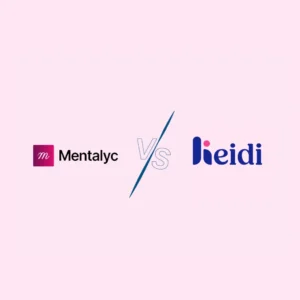Imagine this: you're wrapping up a counseling session when your client drops a bombshell, something significant that they've been holding back until the very last moment. These revelations are known as 'doorknob confessions,' and they can range from emotional disclosures to discussions of potentially harmful situations. But why do clients often wait until the end to share such critical information?
This article explores the fascinating psychology behind doorknob confessions and offers practical strategies for recognizing and handling them while adhering to your ethical obligations as a counselor. We'll also discuss whether you should entertain these disclosures and how to establish boundaries around doorknob confessions in your practice. Are you ready to unlock the secrets of the doorknob confession phenomenon and learn how to create and maintain trust and rapport with your clients?
Significance of Doorknob Confessions for Mental Health Professionals
Mental health professionals use a technique called "doorknob confessions" to collect valuable insights from their clients. This method involves clients sharing significant information during the final moments of a session that they may have been hesitant to reveal earlier. By understanding the reasons behind these disclosures, mental health professionals can build a stronger therapeutic bond with their clients and gain a more comprehensive understanding of their unique experiences.
Additionally, doorknob confessions provide the following benefits:
Insight into Client's Inner World: Therapists can gain valuable insights into their clients' inner world through doorknob confessions. For instance, if a client is reluctant to discuss a specific topic until the end of the session, it may indicate underlying fears or anxieties that must be addressed.
Trust and Rapport Building: Clients who confide their deepest thoughts and feelings with their therapist demonstrate strong trust and comfort in their therapeutic relationship. This trust forms the foundation for meaningful therapeutic work and facilitates greater openness and honesty.
Opportunity for Deeper Exploration: Opening up about personal issues and emotions through doorknob confessions can provide a valuable opportunity for clients to explore and address underlying problems. It creates a supportive space for individuals to work towards healing and finding a resolution.
Enhanced Treatment Outcomes: By addressing the confessions related to doorknobs, therapists can help clients overcome obstacles and achieve breakthrough moments during the treatment, leading to better treatment outcomes.
Understanding the Doorknob Phenomenon
It is not uncommon for therapy clients to suddenly reveal significant information in the final moments of a session. This phenomenon is known as the "doorknob phenomenon." The behavior can be influenced by psychological factors such as fear of judgment, discomfort with vulnerability, or difficulty expressing emotions.
However, this behavior may also indicate that the client is beginning to trust their therapist. Comfortable sharing sensitive or complex experiences can open the possibility of exploring these topics more deeply in future sessions. As a therapist, recognizing the underlying reasons behind the doorknob phenomenon can help you respond more effectively and build a stronger therapeutic relationship with your client.
Exploring Doorknob Comments and Their Meanings
A helpful way to create a comforting and supportive environment for your clients is to pay attention to their non-verbal cues, such as their body language, tone of voice, and other subtle expressions during your interactions. For example, when clients start a conversation by mentioning something unrelated, it could indicate they have sensitive information to share but may be hesitant. Identifying and addressing these cues can promote open communication, build trust, and help clients feel more at ease during therapy sessions.
Examples of Doorknob Comments and Responses:
Client Comment: "I've been meaning to talk to you about something." Therapist Response: Validate the client's courage in bringing up the topic and express willingness to listen and offer support or guidance.
Client Comment: "There's something important I need to share with you." Therapist Response: Acknowledge the significance of the disclosure and create a safe space for the client to express themselves without judgment.
Client Comment: "I've been feeling overwhelmed lately and unsure how to handle it."
Therapist Response: Validate the client's overwhelming feelings and offer strategies for coping or exploring the underlying issues causing distress.
Client Comment: "I've been avoiding talking about this, but I think it's time."
Therapist Response: Acknowledge the client's readiness to address the issue despite previous reluctance and offer support in navigating the discomfort.
Client Comment: "I haven't shared this with anyone else before, but I trust you."
Therapist Response: Express gratitude for the client's trust and reassure them of confidentiality while creating a space for open dialogue.
Mental health professionals can create a positive therapeutic environment by acknowledging and addressing their clients' doorknob comments. This helps clients feel valued and heard, which is crucial for their overall well-being and progress in therapy.
Interpreting Doorknob Comments:
Creating a positive and supportive environment is crucial to ensure that therapy is effective. One way to achieve this is by paying close attention to what clients say, even if it may seem insignificant. Clients may make 'doorknob comments' that reveal their need for validation, support, or guidance. These comments can represent underlying emotions or experiences they may be hesitant to discuss openly. By acknowledging and addressing these comments, therapists can provide clients with a sense of validation and relief while gaining deeper insights into their underlying emotions. Such comments indicate a client's desire for greater connection and understanding within the therapeutic relationship. This can help create a stronger bond and promote more significant healing and growth.
Strategies for Responding to Doorknob Comments
When a client makes a doorknob comment, it presents an opportunity for the therapist to strengthen the therapeutic relationship. Therefore, it is crucial to actively listen to the client, offer verbal affirmations without interruption, and maintain eye contact. Validating their emotions and experiences and acknowledging their courage to share sensitive information can help build trust. Engaging in exploratory dialogue can help to understand the underlying issues and prompt clients to share more. Asking open-ended questions can be an effective way to facilitate deeper exploration and reflection.
Furthermore, reminding clients of confidentiality ensures their privacy and emphasizes trust and safety within the therapeutic relationship. Scheduling follow-up sessions to revisit and explore the topics raised in doorknob comments provides ongoing support and guidance to clients as they progress through their therapeutic journey. Establishing clear boundaries around doorknob confessions is essential, as well as ensuring ethical practice, managing disclosures within session time constraints, and referring clients to appropriate resources if necessary.
Practical Tips for Responding to Doorknob Comments:
To effectively communicate empathy and understanding, it's essential to:
Practice active listening and maintain open body language.
Use reflective statements to validate a client's emotions and experiences
Rather than rushing to provide solutions, focusing on exploring the client's thoughts and feelings is necessary.
Regularly reviewing and reinforcing confidentiality agreements can help reassure clients of their privacy and safety.
Overall, a constructive approach to communication can help create a positive and supportive environment for clients.
Self-care and Professional Support
Therapists have a good understanding of the emotional challenges that come with helping clients through difficult times. To provide high-quality care, we must prioritize our emotional well-being. Activities that promote relaxation, stress reduction, and work-life balance, such as hobbies or mindfulness exercises, can help us replenish our emotional resources. Seeking guidance from experienced colleagues, participating in peer support groups, and pursuing ongoing professional development in trauma-informed care and boundary setting can further enhance our skills for handling challenging situations. It's essential to set clear boundaries between our personal and professional lives, and accessing personal therapy to safeguard our well-being while providing excellent care is critical.
Integration and Considerations for Your Therapeutic Practice
Incorporating reflective practice into your daily routine can significantly improve your skills and provide optimal care continuously. By maintaining and discussing a journal with colleagues, you can assess your experiences and strengthen your emotional resilience. Additionally, keeping up with current research, theories, and best practices in your field is essential to deliver the best care possible. To build trust with your clients, it is crucial to be empathetic, authentic, and non-judgmental while being adaptable and responsive to their diverse needs and upholding ethical principles and professional standards. Integrating your experiences handling "doorknob confessions" into your ongoing professional development can enrich your care and support for your clients. Encouraging cultural humility, self-reflection, and learning to recognize biases and limitations are constructive practices to enhance your skills and provide better care. Lastly, always prioritize ethical considerations, such as confidentiality and informed consent, to ensure the well-being and safety of your clients while delivering the highest level of care.
Conclusion
It is crucial to remain attentive to any subtle hints your client may reveal toward the end of a therapy session. These unexpected comments or thoughts could hold significant meaning and offer a unique opportunity to deepen the therapeutic bond with sensitivity and expertise. It is advisable to embrace the chance to continue the conversation in the next session, fostering a safe and secure environment for your clients to express themselves freely. With your compassion and professionalism, you can gracefully navigate these 'doorknob confessions,' ultimately enriching the therapeutic relationship rather than disrupting it.
Recognizing the significance of these doorknob confessions empowers mental health professionals to cultivate trust, insight, and meaningful exploration within the therapeutic relationship. By responding thoughtfully and empathetically, therapists can effectively support their clients on their journey toward healing and growth. Maintaining confidence in yourself and the therapeutic process is indispensable, as each doorknob confession presents an opportunity for profound connection and meaningful progress.
Are you tired of drowning in paperwork and documentation? Let Mentalyc, a HIPAA-compliant and AI-powered software, help you ease your burden and enhance your productivity. Our user-friendly tool enables you to revolutionize how you document client sessions, seamlessly recording insights, reflections, and progress in real-time. Say goodbye to the hassle of manual note-taking and hello to more meaningful client engagements. Sign up for our free trial today and witness the difference for yourself. Your clients—and your peace of mind—will thank you.
Doorknob Confessions FAQs: Answering Common Questions
What qualifies as a doorknob confession?
A doorknob confession refers to sensitive information clients share at the end of a therapy session as they leave, often just as their hand is on the doorknob. This last-minute revelation of emotional details or critical life events can catch therapists off guard, leaving little time to address it adequately. Common examples include disclosing trauma, relationship issues, suicidal thoughts, or other mental health crises.
Why do clients wait until the end of a session?
There are a few reasons why clients may wait until the end to share essential details:
They feel more comfortable opening up as the session ends when there's less time to explore the issue in depth. This can feel less threatening.
They've gained trust in the therapist throughout the session and feel ready to disclose but run out of time.
They're avoiding discussing the issue by waiting until the end when there are time constraints. This can be a defense mechanism.
The realization of what they need to share only arises at the end of the session.
Emotions and memories can surface unexpectedly.
How should therapists handle doorknob confessions?
Doorknob confessions require sensitivity and care:
Listen without judgment and validate the client's feelings. Say something like, "I appreciate you sharing this with me."
Assure the client you will keep the information confidential.
Ask open-ended questions to understand the issue better while acknowledging the time constraints. For example, "I want to respect your time, but could you briefly tell me more about this so I understand better?"
Schedule an additional session to explore the revelation as soon as possible fully. Let the client know you take their disclosure seriously and want to provide them with your full support and attention.
Consider whether a referral to a psychiatrist or crisis center is needed, especially if the client expresses suicidal thoughts. The client's safety must come first.
Explain that while you want to address their confession correctly, the session time has ended. Reassure them you will revisit the issue in full at the next appointment. Your patience and understanding can help build trust in the therapeutic relationship.
How do therapists perceive doorknob confessions?
For therapists, doorknob confessions can be challenging but also rewarding. They show the client has gained enough trust and comfort to share openly, which is a milestone. However, the timing constraints mean the therapist may feel unprepared to support the client properly. With experience, therapists can become adept at sensitively handling doorknob confessions and turning them into an opportunity to strengthen the therapeutic alliance.
Resources:
Artz, N. (2023, June 23). What Is a Doorknob Confession & Why You Do It. Choosing Therapy. https://www.choosingtherapy.com/doorknob-confession/
Brenner, G. H. (2021, May 1). What Comes Out at the End of Therapy, and Why It Matters. Psychology Today. https://www.psychologytoday.com/us/blog/experimentations/202105/what-comes-out-at-the-end-of-therapy-and-why-it-matters
Frye, N. (2024, February 12). How to Handle Doorknob Confessions as a Therapist. Rula. https://www.rula.com/blog/doorknob-confessions/
Gitlin, D. V. (2022, January 17). Doorknob Moments: Why They Happen and How to Use Them. Psychiatric Times. https://www.psychiatrictimes.com/view/doorknob-moments-why-they-happen-and-how-to-use-them
Maharaj, N. (2022, May 17). Unpacking "Doorknob Confessions": An Avoidance Tactic Our Brains Employ in Therapy. Byrdie. https://www.byrdie.com/doorknob-confessions-therapy-5222312
Practical Psychology. (2023, October 14). Doorknob Confession (Explanation + Management Tips). https://practicalpie.com/doorknob-confession/
Why other mental health professionals love Mentalyc

“If I were recommending this software to a colleague, I would tell them that it is the best thing that they could do for their practice.”
Licensed Professional Counselor

“Do yourself a favor, make your life easier. Use the tools that are readily available … I found Mentalyc to be one of the best tools that I’ve ever used.”
Licensed Marriage and Family Therapist

“For those who have hesitations … It is a lifesaver. It will change your life and you have more time to be present with your patients.”
Licensed Clinical Social Worker

“It immediately changed my quality of life, personally and professionally. I went from 3–4 hours a week of notes to 1 hour at most … that alone is invaluable personally and professionally.”
Owner/Independently Licensed Marriage & Family Therapist (IMFT)






